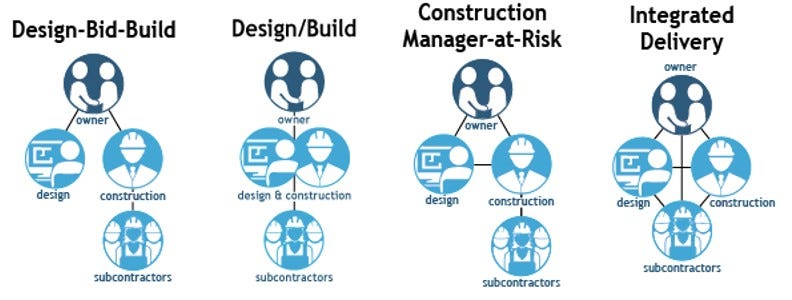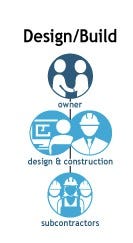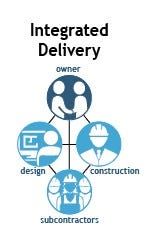Construction Curiosities #119
What Construction Delivery Method is Best?? | ConTech Benchmark Report
Hey! Happy Saturday! Matt here.
Welcome to the Construction Curiosities newsletter!
It’s still May, so we are still talking through Procurement and Contracting.
Summary
This week we will look at:
One Musing: Delivery Method 101
Contech Corner: AEC SaaS Benchmark
One Meme: Low Bid Adventure
Delivery Method Breakdown (Stupid Simple Guide)
People throw around delivery methods like they’re essentially the same.
They’re not.
Each one shifts risk, speed, cost control, and accountability in different directions.
Design-Bid-Build (DBB)
The OG method. Architect completely finishes the design. Bidders compete. Lowest price wins. Can also be procured through a “Competitive Sealed Bid” where price and technical proposal play a role.
Pros:
Straightforward and familiar to most Owners
Max transparency through open bidding
Owner keeps full design control
Best option for low complexity, high competition markets
Cons:
Lowest bid ≠ best value (hello, change orders)
Can’t negotiate post-bid
If over budget? Start over and rebid
Longer overall schedule (no overlap)
Requires the Owner to be very hands-on
Best for:
Public projects where budget trumps speed or innovation. And where the design is fully baked. (is it ever tho?)
Construction Manager at Risk (CMAR / CM@R)
You bring in the Contractor during design under a Pre-Con contract. They help shape the drawings to keep things constructable and within the Owner’s budget. They set a GMP (Guaranteed Maximum Price) around the 100% DD stage and then move to the other side of the table and become your GC.
Pros:
Early cost feedback and constructability input
Contractor Accounting is an Open Book
Can phase the construction and buy out long lead items early
Reduces surprises → fewer change orders
Design, estimating, and build teams collaborate in real time
Great for complex projects or renovations
Cons:
Not the cheapest up front
Can be admin-heavy (contracting, procurement, GMP negotiation)
Owner must understand the process and manage it well
Still needs a clear scope to hit the GMP target
Best for:
Complex public projects, fast-moving markets, or when the Owner wants flexibility and visibility.
Design-Build (DB)
One team owns the design and construction process. You get speed and simplicity but you give up a good bit of control.
Pros:
Fastest of the bunch (design and build overlap)
One contract = less finger-pointing
Potentially fewer change orders
Better coordination between field + design
Cons:
Architect works for the contractor, not you
Harder to control design quality
Pricing isn’t always competitive (especially if not open-book)
High trust required
Best for:
Schedule-driven projects where the Owner can articulate their vision up front, then step back.
Job Order Contracting (JOC)
For ongoing small jobs. Think: unit pricing for “on-call” repairs, minor reno, MEP refreshes, etc.
Pros:
Speedy. No need to rebid every small project
Predictable pricing with minimal paperwork
Great for repetitive scope
Multiple JOCs can be awarded
Cons:
Not ideal for complex or one-off builds
Owner must monitor pricing as unit costs don’t always scale
Quality control depends heavily on vendor oversight
Best for:
Facility maintenance programs, campus-wide refreshes, or public Owners who need work done fast without reinventing the wheel each time.
Integrated Project Delivery (IPD)
The Unicorn contract (as I’ve never seen one in the wild).
But also the kumbaya contract. Owner, Architect, Contractor, and key trades all sign one agreement to share risks and rewards. In theory, it’s collaboration on steroids. In reality? Likely too good to be true.
Pros:
True team alignment. No adversarial relationships
Incentivizes cost savings and schedule performance
Encourages early problem-solving instead of finger-pointing
Best shot at innovation and total lifecycle thinking
Cons:
Requires a ton of legal and cultural buy-in (see above about Unicorns and being too good to be true…)
Very few teams know how to actually execute it
Slippery slope if one party stops playing nice
Not ideal for teams without repeat work or shared history
Best for:
Supposedly best for healthcare, higher-ed, or tech campuses with trusted design and build partners, and an Owner who knows how to effectively lead a team without being a tyrant or a ghost.
Final Word:
So which Method is best??
That depends.
You’re not picking a “better” method.
You’re picking the one that sucks the least for your specific mix of:
Budget
Schedule
Risk tolerance
Project complexity
ConTech Corner/ One Article
SaaS Benchmarking: What’s changed in AEC SaaS since 2023?
A deep dive into 2025 AEC software benchmarking, comparing financial performance and efficiency across leading industry players and top SaaS companies.
It’s a combo this week as we look at this article from Foundamental. It’s an interesting deep dive, but here’s the TDLR:
Adobe outperforms the entire AEC sector on Rule of 40 despite equal growth rates - demonstrating superior operational efficiency with the same top-line growth
Procore's negative margins persist after 22 years in business - though showing improvement, still an outlier among mature software companies
Sales efficiency correlates directly with ecosystem strength and product stickiness - companies with integrated product suites and strong user communities demonstrate superior unit economics
Intuit and Adobe set the gold standard for operational efficiency - achieving nearly $900K and $700K in annual revenue per employee, respectively
Procore is primed to be knocked off… who is it going to be?
One Meme
You won’t always know they were low bid…
But there will be signs.
In a Design Bid Build, low-bid project, many times you get what you pay for…
Construction Curiosities is a reader-supported Newsletter. Please consider upgrading your subscription to help support the work we are doing.













Great overview Matt. My recommendation: always shape the delivery method to suit the project—not the other way around.
Each method has its place, but the best outcomes come when the contract structure reflects the project's specific needs, risks, and constraints. One size doesn’t fit all, and forcing a project to match a contract model often creates more problems than it solves.
The construction delivery method newsletter is a very good simple read!
What can you share about “design assist” contracts and/or subcontracts? I always hear different explanations both from colleagues and online resources.
Thanx